|
Voice tools are versatile, engaging, and collaborative Web 2.0
tools that allow students to practice their oral skills inside and
outside the classroom and receive feedback on their performance both
synchronously and asynchronously.
The reasons for which we began to exploit asynchronous voice
tools are manifold. First, we felt the need to extend our students’
talking time beyond the class into a safe and motivating environment
where they could practice at their own pace and at the most convenient
time. This environment was expected to offer equal chances to speak to
less proficient students who were more reticent to speak in class for
fear of losing face in front of more proficient ones. Such students
could rehearse and prepare beforehand and record only when satisfied
with their production. Because repetition is the mother of learning,
there was a hidden target here that could not function as such,
especially with adult students. However, in asynchrony and the comfort
of one’s own home, it worked perfectly because less proficient students
revised, re-edited, and re-recorded until satisfied with their output.
Another compelling reason for asynchronous voice tools adoption
was the extension of the students’ exposure to other different accents
of real people from all over the world, both native and nonnative
speakers of English. Listening to real voices was motivating for some
students as they were no longer afraid of sounding less perfect or of
speaking with a specific accent, which is crucial especially in the case
of more adult learners.
All in all, voice tools can be exploited by language teachers
in order to increase the students’ confidence in their own
speaking.
VOXOPOP: AN OPEN WINDOW TO REAL SPEAKING PRACTICE
Voxopop (VOP), available at www.voxopop.com,is one of
the most user-friendly, free, and versatile asynchronous voice tools
that can be used to build an audio discussion. This is why teachers who
feel they face the issues mentioned before and are less familiar with
technology can start spicing up their lessons with voice technology by
using Voxopop.
VOP is a message board with real voices. It is like a message
left after the beep of an answer phone, but this message is then
commented on or taken a step forward by other participants. Teachers can
either create their own talkgroups according to the topics they want,
or guide their students to explore and join existing ones. These many
ready-made VOP talkgroups and categorized discussions where students can
participate are an advantage over synchronous voice tools such as chat.
You can browse ongoing conversations by topic (spirituality, business, computers & technology,
entertainment, art, health, lifestyle, science, nature, society, and
culture), by recently updated, or even by keywords.
You can listen to most messages of existing talkgroups;
however, if you want to start adding messages, you will need to join
them. Then you can just click the “Record a Message” button and add your
message.
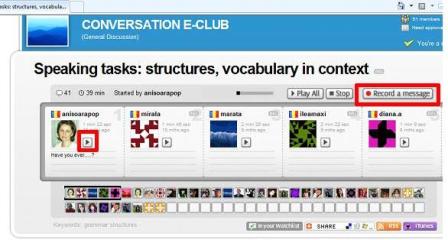
Right after that, a new window will pop up with a simple
toolbar. Then, once you have your microphone on and you are ready to
speak, just click on the red button and start talking.
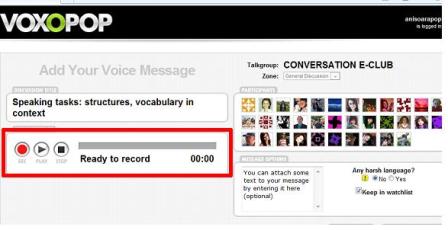
If you want to create a talkgroup, you have to open an
account at www.voxopop.com, then click
on “Create a talkgroup” and fill in the details of your talkgroup: name,
type and category, as well as access level (i.e., open, restricted or
private). For restricted talkgroups, the administrator’s approval is
needed to join; private talkgroups also require this approval and are
hidden from the public, and so are ideal for classrooms with constraints
on students speaking in public.
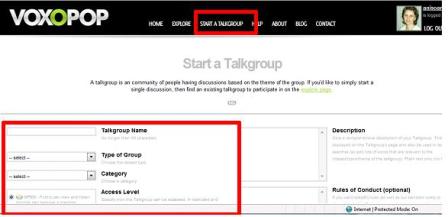
You can select an image, color scheme, description, rules of
conduct, and discussion zones, then click “Create my Talkgroup.” After
creating it, you can invite students to join (click “Invite”) or simply
give them the talkgroup URL and ask them to join.
Anyone can explore and listen to public discussions, but only
signed-up users can start or join talkgroups. A recently introduced
feature enables the teacher as talkgroup administrator to delete
improper content (individual comment) or a whole discussion. Moreover, a
very convenient feature for teachers is the e-mail notification, which
can be enabled so that you are e-mailed whenever a new
studentcontributes.
In order to start the talkgroup discussion and record the
instructions for your students, you have to click “Start a talkgroup
discussion” and then the red recording button. Java will be activated
for voice recording, so make sure you have its latest version (although
your computer should usually do this job automatically). When you are
ready, stop recording and then press the “Play” button in order to
listen to your production. Save it if satisfied or delete it and record
again if you need to improve.
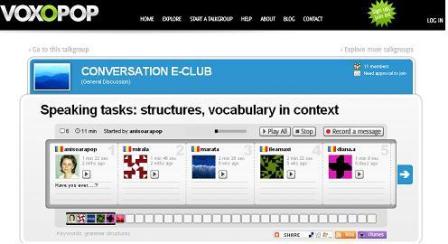
For further information on how to use Voxopop, check out Nicholas
Peachey’s tutorial.
SUGGESTED ACTIVITIES FOR THE LANGUAGE CLASSROOM
VOP can be used with different levels, from elementary to
advanced, with a whole range of integrated reading, listening and
writing activities involving both grammar and vocabulary in the same way
we do in class. The crucial difference is that now students speak from
home and can be heard from anywhere in the world.
For vocabulary practice and discussion,
students can be invited to express their opinions (say on their favorite
food, hobby, ideal holiday, future job), to describe (themselves or
their houses, town, school, experiences, routines), to discuss an
article in the newspaper or their coursebook, to bring arguments for and
against a certain topic, to negotiate, to agree or disagree, to
reflect, and so on. A good suggestion for this type of activities is to
record a series of statements and ask students to respond to each
one.
Practicing structures in context can also be
easily adapted with VOP(you can listen to an example of the present
perfect being practiced here).
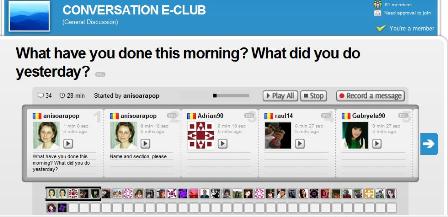
Alternatively, VOP can be employed to improve pronunciation (record some pronunciation drills and
get students to repeat them and record themselves), for dictation purposes (record your own dictation texts,
then ask students to write down what they hear and then record their own
version), and also as an assessment tool or for tutorials in order to guide students without the
teacher being physically there.
For more suggestions on how to use Voxopop in the classroom,
check the
talkgroup BaW09 Voice Tools for Teaching.
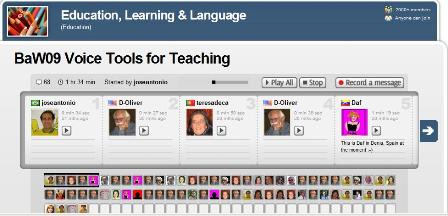
CONCLUSION
To sum up, this tool can be described as user-friendly,
engaging, collaborative, authentic, suited for all levels, and, most
important of all, an excellent way to fight against students’ timidity,
and especially to allow and encourage real communicative speaking and
listening practice outside the classroom walls.
The advantages are not only for students, but also for teachers
who can keep a record of their students’ speaking and assess their
pronunciation and also their progress.
All in all, VOP is a great tool that can help teachers raise
their students’ confidence in their speaking abilities and provide a
venue for engaging, accessible, and authentic EFL speaking activities.
Susana Gómez is a
professor of undergraduate and postgraduate courses at the University
of Valladolid, the editor of TESOL-SPAIN Newsletter, a
reviewer of TESOL Journal and The Asian
EFL Journal, a TESOL-SPAIN Board member, and the supervisor of
Cambridge ESOL exams at the University of Valladolid. She is a regular
speaker at TESOL conventions and has written several articles on SLA and
EFL methodology.
Anisoara Pop is
an associate professor at Dimitrie Cantemir University, Targu Mures,
Romania. She holds a doctorate in linguistics and has been teaching
EFL/ESP for 22 years. Her main current interest is in enhancing English
learning with Web 2.0 tools. | 
